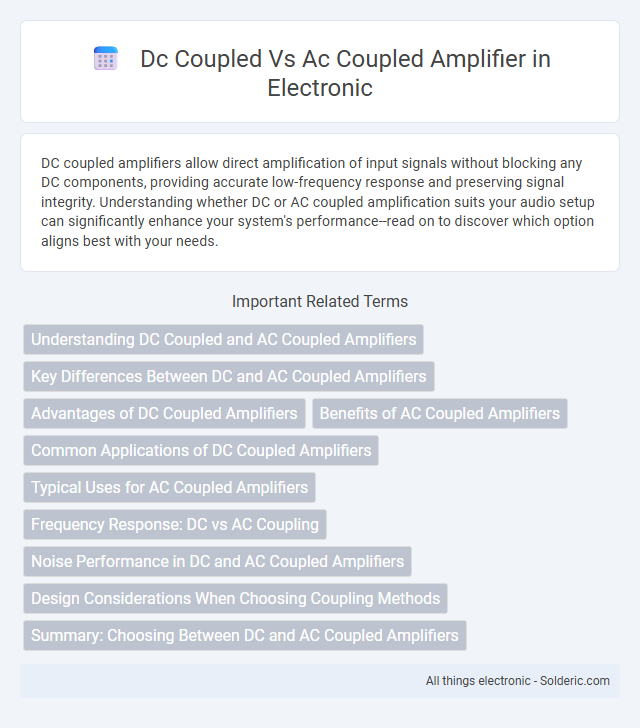DC coupled amplifiers allow direct amplification of input signals without blocking any DC components, providing accurate low-frequency response and preserving signal integrity. Understanding whether DC or AC coupled amplification suits your audio setup can significantly enhance your system's performance--read on to discover which option aligns best with your needs.
Comparison Table
| Feature | DC Coupled Amplifier | AC Coupled Amplifier |
|---|---|---|
| Signal Type | Amplifies both DC and AC signals | Amplifies AC signals only; blocks DC offset |
| Coupling Method | Direct electrical connection | Uses capacitor or transformer for coupling |
| Frequency Response | Wideband, includes low-frequency and DC | Limited low-frequency response due to coupling components |
| Offset Voltage | Can amplify DC offset, causing drift | Blocks DC offset, stabilizing output baseline |
| Application | Sensor signal conditioning, low-frequency measurements | Audio amplification, AC signal processing |
| Complexity & Cost | Generally simpler, lower cost | Additional components increase complexity and cost |
Understanding DC Coupled and AC Coupled Amplifiers
DC coupled amplifiers directly connect the input signal to the amplification stage, preserving both AC and DC components, making them ideal for applications requiring accurate low-frequency response and DC signal measurement. AC coupled amplifiers use capacitors to block DC components, allowing only AC signals to pass through, which helps eliminate DC offset and is suitable for audio and communication systems where DC shifts can cause distortion. Understanding the differences in coupling methods helps you select the right amplifier for precise signal processing depending on whether you need to maintain DC integrity or remove unwanted DC bias.
Key Differences Between DC and AC Coupled Amplifiers
DC coupled amplifiers transmit both AC and DC signals without blocking any frequency components, making them ideal for applications requiring accurate low-frequency or DC measurements. AC coupled amplifiers incorporate capacitors at the input or output to block DC components, allowing only AC signals to pass, which helps eliminate DC offset and drift issues. Understanding these key differences helps you select the appropriate amplifier type based on your signal characteristics and application needs.
Advantages of DC Coupled Amplifiers
DC coupled amplifiers provide a continuous frequency response down to 0 Hz, enabling accurate amplification of low-frequency and DC signals without distortion. They eliminate the need for coupling capacitors, reducing phase shift and signal loss, which is crucial for precision measurement and sensor applications. Your system benefits from improved linearity and stability, making DC coupled amplifiers ideal for applications requiring faithful reproduction of input signals.
Benefits of AC Coupled Amplifiers
AC coupled amplifiers offer improved noise rejection by blocking DC offset and low-frequency drift, ensuring cleaner signal amplification. They provide enhanced stability in circuits sensitive to DC variations, making them ideal for audio and communication applications. The ability to isolate stages without affecting biasing conditions optimizes overall amplifier performance and reliability.
Common Applications of DC Coupled Amplifiers
DC coupled amplifiers are commonly used in applications requiring accurate low-frequency or DC signal amplification, such as sensor signal conditioning, bio-potential measurements like ECG and EEG, and instrumentation systems. They provide direct coupling between input and output, preserving the true DC component of the signal without distortion or offset drift. These amplifiers are essential in precision measurement systems where signal integrity at zero frequency is critical.
Typical Uses for AC Coupled Amplifiers
AC coupled amplifiers are commonly used in audio and radio frequency applications where removing DC offset is crucial to prevent signal distortion and amplifier damage. They excel in coupling stages of audio equipment, wireless communication devices, and instrumentation systems by blocking unwanted DC components while preserving the integrity of the AC signal. Your audio or RF system benefits from improved signal clarity and stability by incorporating AC coupled amplifiers where signal isolation is necessary.
Frequency Response: DC vs AC Coupling
DC coupled amplifiers provide a wide frequency response starting from 0 Hz, allowing accurate amplification of both low-frequency signals and DC components. AC coupled amplifiers incorporate coupling capacitors that block DC signals, resulting in a high-pass frequency response typically above a few Hertz, which eliminates low-frequency drift and DC offset. For applications requiring true low-frequency or DC signal measurement, DC coupling is essential, whereas AC coupling is preferred for signals where slow baseline variations must be suppressed.
Noise Performance in DC and AC Coupled Amplifiers
DC coupled amplifiers exhibit lower noise performance at low frequencies due to the direct connection between input and output, eliminating noise from coupling capacitors. AC coupled amplifiers can introduce additional noise and signal distortion because coupling capacitors block DC signals and may generate leakage currents or dielectric absorption. Your choice of amplifier coupling directly impacts signal integrity and noise floor, especially in precision measurement applications.
Design Considerations When Choosing Coupling Methods
Design considerations when choosing between DC coupled and AC coupled amplifiers center on signal integrity and application requirements. DC coupling preserves low-frequency response and allows direct amplification of signals with zero or near-zero frequency components, crucial for sensors or DC level detection, but demands careful offset management and power supply regulation to avoid drift. AC coupling eliminates DC offsets and low-frequency noise through capacitive coupling, simplifying design for audio or AC signal amplification but limiting bandwidth and potentially introducing phase shifts.
Summary: Choosing Between DC and AC Coupled Amplifiers
DC coupled amplifiers provide continuous signal transmission with accurate low-frequency response and minimal phase distortion, making them ideal for applications requiring precise waveform reproduction. AC coupled amplifiers include coupling capacitors that block DC components, effectively reducing offset and drift but limiting low-frequency performance and introducing phase shifts. Selection depends on whether preserving DC information and low frequencies is critical (favoring DC coupling) or if eliminating DC offsets and minimizing baseline drift is more important (favoring AC coupling).
dc coupled vs ac coupled amplifier Infographic

 solderic.com
solderic.com